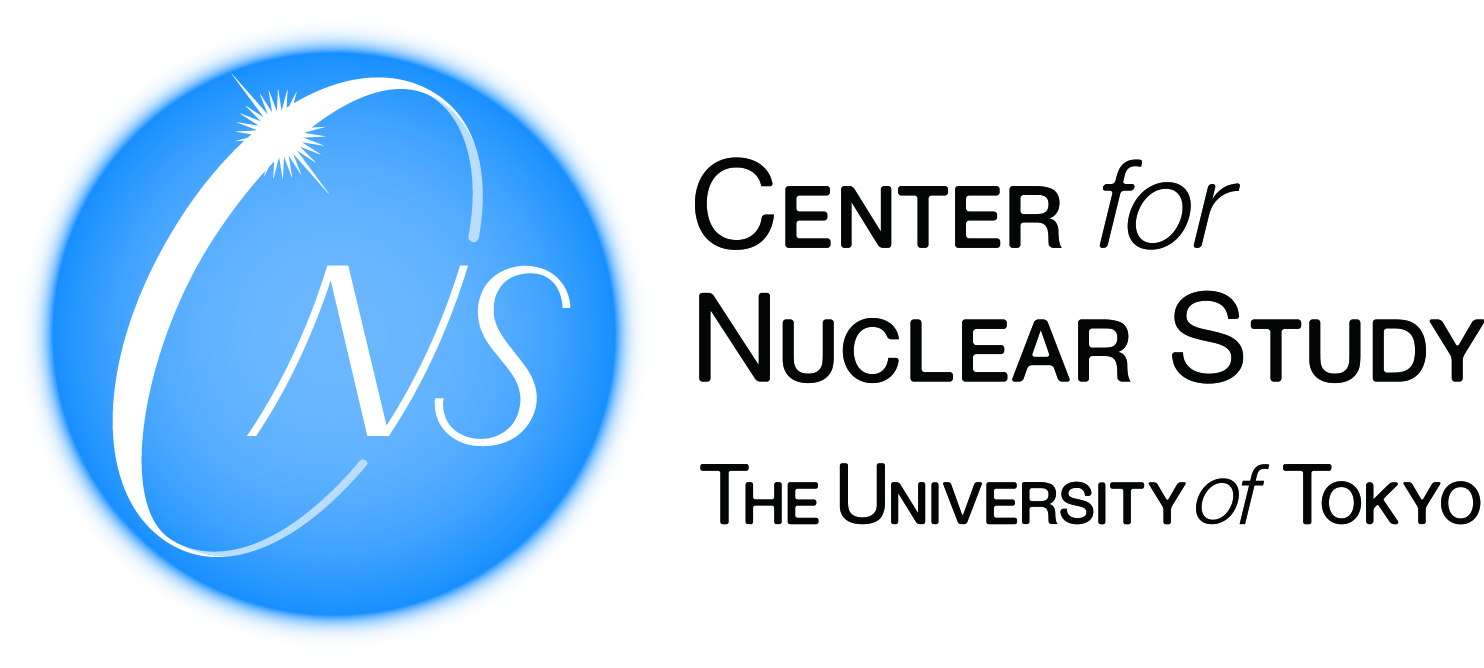
Nuclear Structure
Dynamics
Nuclear Structure
原子核は陽子数や中性子数が変化させた時に、従来の常識を覆す現象が発現します。 自然に安定に存在する原子核では、スピン軌道角運動量相互作用によって作られる秩序が 陽子数や中性子数がアンバランスな原子核では、テンソル力や、四重極相関が働き、秩序の様相が変わってきます。最近では、変形球形の形状相転移といった現象も報告されてきました。 高精度の質量測定、インビームガンマ線核分光、陽子共鳴散乱等、様々なプローブを用いて、 多面的に、原子核を構成する秩序を司る物理に迫ります。(青井研究室、(Imai Lab.)
Quantum Phase Transition in Zirconium Nuclei
In neutron-rich zirconium (Zr, Z = 40), it has long been known that when the mass number increases from A = 98 to A = 100, the ground-state shape suddenly undergoes aquantum phase transition from spherical to “lemon”-shaped.Recently, the CNS Theory Group proposed a shape-coexistence model in which even the excited states of the stable Zr isotopes already exhibit a lemon shape,and this configuration crosseswith the spherical one precisely at A = 99.
Shape coexistence occurs when multiple mean-field vacua (distinct equilibrium shapes) appear as the nucleus deforms.
A quantum phase transition takes place when the relative energies of these vacua shift as a function of nucleon number, causing one shape to become the new ground state. Although Zr exhibits two coexisting vacua, nuclei with three have also been identified—yet the properties of each vacuum remain largely unexplored.
To probe these distinct vacua, our group proposed using proton-resonance scattering followed by decay spectroscopy.
As a proof-of-principle—and to uncover the mechanism driving the quantum phase transition in Zr—we performed a proton-resonance scattering experiment on ⁹⁶Zr at Kyushu University’s tandem accelerator facility96. We observed resonances with different spin-parity assignments, directly revealing the shapes of the corresponding excited states. This method opens the door to detailed investigations of even more neutron-rich Zr isotopes in the future.


Mass Measurements of Short-Lived Rare Nuclei
Themass of an atomic nucleus—one of the most fundamental quantities describing its energy states—is determined by the combined effects of all nucleon–nucleon interactions, including the strong (nuclear) force and the Coulomb force. By measuring nuclear masses directly and mapping out their systematics (e.g. as functions of neutron and proton number), we gain critical insight into how nuclear energy structure evolves. We have developed a technique that pairs extremely neutron-rich or proton-rich beams from RIKEN’s accelerator complex with our own high-resolution beamline and the SHARAQ magnetic spectrometer. This setup enables us to measure the masses of rare nuclei whose lifetimes are only a few milliseconds.Developments)
Applying this method, we are now uncovering the masses and underlying structure of nuclei in regions of the nuclear chart that have never before been explored.


Zeptosecond Dynamics
When roughly twenty neutrons are added to nihonium-278 (278Nh; Z = 113; t₁/₂ ≈ 2 ms), theory predicts the emergence of an“island of stability”—a region of nuclei whose half-lives exceed years. Discovering these long-lived superheavy nuclides would profoundly advance our understanding of nuclear quantum‐system stability. Because fusion of two stable nuclei cannot supply enough neutrons, one promising route is to use very neutron-rich radioactive isotopes.
To exploit heavy‐ion fusion effectively, it’s essential to understand not only fission but also the competing process known asfusion-hindrance (or fusion suppression). Experimental data to date suggest an exponential dependence of the fusion probability on the product of the target and projectile proton numbers, yet model uncertainties span roughly two orders of magnitude.
In the Nuclear Dynamics Laboratory (Imai Group), we are using the high-intensity136Xe beam at QST-HIMAC to produce isotopes from polonium (Po, Z = 84) through neptunium (Np, Z = 93). By measuring fusion yields and cross sections under well‐controlled conditions, we aim to quantify fusion-hindrance effects on a zeptosecond timescale.


charged particle detection
2025 School of Science Calendar
Exotic deformation
Nuclei are often depicted as perfect spheres in high-school textbooks—but in reality, the momentum- and energy-space correlations among their constituent protons and neutrons can spontaneously break that symmetry and produce a variety of shapes. In quadrupole-deformed nuclei, for example, “superdeformed” and even “hyperdeformed” states appear. More exotic configurations—such as octupole deformation, tetrahedral arrangements, linear-chain structures, and toroidal (“doughnut”) shapes—have also been predicted. These non-spherical shapes are understood as manifestations ofself-organization」の現れとして理解されます。変形状態の探索により、破れた対称性がどのように回復し、集団運動が誘起されるのかを 調べます。 (青井研究室、(Imai Lab.)

(引用:Frank, A., Jolie, J., Isacker, P.V. (2019). Symmetry in Nuclear Physics: The Shell Model. In: Symmetries in Atomic Nuclei. Springer Tracts in Modern Physics, vol 230. Springer, Cham. https://doi.org/10.1007/978-3-030-21931-4_2)
Collective Motion
By probing the nucleus via nuclear scattering, we can excite it into rotational and vibrational modes. This phenomenon—called nuclear collective excitation—reflects fundamental properties of the nucleus, such as its stiffness, and has long been a central topic in nuclear physics.
The Exotic Nuclear Reactions Group uses unstable beams from RIBF to study the interactions that give rise to new collective behaviors and novel nuclear phenomena. (Yako Lab.)
Exploration of the Double Gamow–Teller Giant Resonance
Tetra Neutron
Neutron stars —the final evolutionary stage of massive stars—can be viewed as“ultra-giant nuclei”composed almost entirely of neutrons, exhibiting extreme phenomena far beyond anything found on Earth. By creating the never-before-observed tetraneutron(an atomic nucleus of just four neutrons, Z = 0)in the laboratory, we can probe the exotic nuclear forces at play inside neutron stars. We probed tetra neutron system using a double charge-exchange reaction8He + 4He → 8Be + 4n, succeded in producing a four-neutron state with minimal recoil. This experiment, carried out with the SHARAQ spectrometer that CNS designed and built, revealed a clear resonance just above the four-neutron emission threshold—an effect that cannot be explained by existing theories and points toward novel many-neutron correlations. These results establish the tetraneutron as the first step into a new research field—“many-neutron nuclear physics”—with the promise of uncovering uncharted nuclear matter.
Building on our 4n observations, in 2023 a second experiment at RIKEN’s SAMURAI spectrometer used a knock-out reaction8He + p → p + 4He + 4n to produce tetraneutrons with much higher efficiency. The high-statistics data unambiguously confirmed the tetraneutron’s existence, resolving a half-century of debate over whether a strongly correlated four-neutron state could exist. Also in 2023, in collaboration with Associate Professor Miki’s group at Tohoku University, we used SHARAQ to study the three-neutron (3n) system, yielding new insights into neutron-rich matter. For pioneering the first experimental evidence of the tetraneutron, Professor S. Shimoura (University of Tokyo; now RIKEN ) was awarded the Nishina Memorial Prize for his work on the “Experimental Study of the Four-Neutron State.”(Imai Lab./ 旧下浦研究室)





